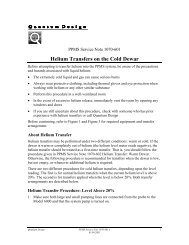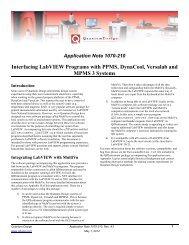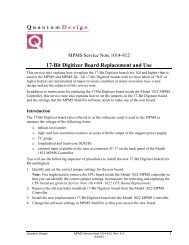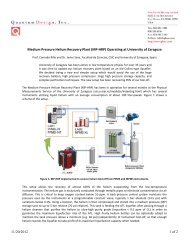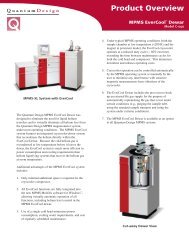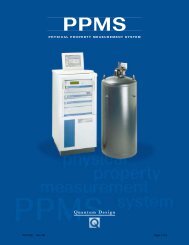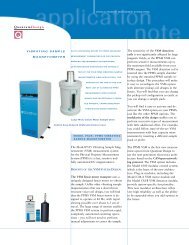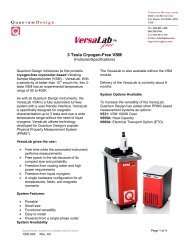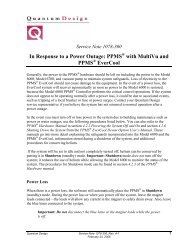Interfacing 3rd Party Instruments to the PPMS Software Environment
Interfacing 3rd Party Instruments to the PPMS Software Environment
Interfacing 3rd Party Instruments to the PPMS Software Environment
You also want an ePaper? Increase the reach of your titles
YUMPU automatically turns print PDFs into web optimized ePapers that Google loves.
2. IEEE-488.2 Recommendation<br />
Depending on <strong>the</strong> type of instrument being connected <strong>to</strong> <strong>the</strong> GPIB bus, one may encounter<br />
problems with incomplete GPIB pro<strong>to</strong>cols from <strong>the</strong> third party instrument. Although many<br />
instruments state GPIB compatibility, not all GPIB capabilities are <strong>the</strong> same. The current<br />
accepted GPIB pro<strong>to</strong>col is IEEE-488.2; <strong>the</strong> <strong>PPMS</strong> Model 6000 uses this pro<strong>to</strong>col. O<strong>the</strong>r<br />
instruments (especially older models) may only be following <strong>the</strong> IEEE-488.1 or older pro<strong>to</strong>col.<br />
The result of having incomplete pro<strong>to</strong>cols may result in <strong>the</strong> lock up of <strong>the</strong> GPIB bus such that a<br />
complete GPIB reset becomes necessary <strong>to</strong> release <strong>the</strong> network. If you feel that you may be<br />
having GPIB problems with your program, you can test whe<strong>the</strong>r <strong>the</strong> problem is due <strong>to</strong> GPIB<br />
pro<strong>to</strong>col by modifying your programs so that <strong>the</strong>y are still performing communications <strong>to</strong> <strong>the</strong><br />
Model 6000 but are not querying <strong>the</strong> third party instruments. You should also physically<br />
disconnect <strong>the</strong> instrument from <strong>the</strong> GPIB network. If <strong>the</strong> modified program runs, when <strong>the</strong> third<br />
party instrument is physically disconnected and masked from <strong>the</strong> program, <strong>the</strong>n <strong>the</strong>re may be<br />
problems with <strong>the</strong> third party instrument. If you have several instruments connected <strong>to</strong> <strong>the</strong> GPIB<br />
bus, you may want <strong>to</strong> do this with each instrument until you find <strong>the</strong> instrument at fault.<br />
Fur<strong>the</strong>rmore, <strong>the</strong>re are several universal command strings, which all IEEE-488.2 instruments<br />
accept (such as *IDN?). If <strong>the</strong> instrument being used is an IEEE-488.2 system it should respond<br />
<strong>to</strong> <strong>the</strong>se universal commands. In summary, if you interface instruments using IEEE-488.1 or<br />
older pro<strong>to</strong>col, you should take care when writing your program for proper communication.<br />
3. Command Strings and Sequences<br />
When <strong>the</strong> Model 6000 is running a sequence, any resources being used by <strong>the</strong> sequence becomes<br />
unavailable for interactive operation. For example when <strong>the</strong> Model 6000 is performing a scan H<br />
sequence, <strong>the</strong> application program cannot send a command string <strong>to</strong> <strong>the</strong> Model 6000 <strong>to</strong> change<br />
<strong>the</strong> field. Conversely, any environment resources not being controlled by <strong>the</strong> sequence remains<br />
available <strong>to</strong> <strong>the</strong> user for interactive operation. Of course any read-only parameters (such as<br />
GetDat?) can be obtained using command strings, even when it is being used in <strong>the</strong> sequence.<br />
Quantum Design <strong>PPMS</strong> Application Note 1070-202 B 12<br />
04/09/2002



